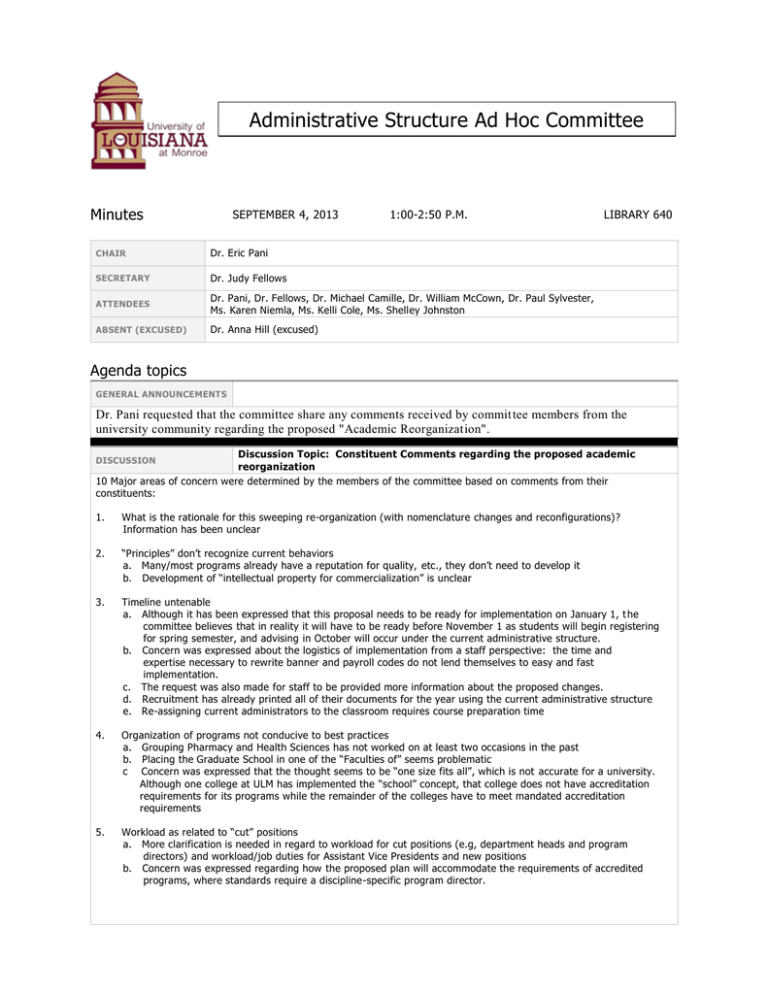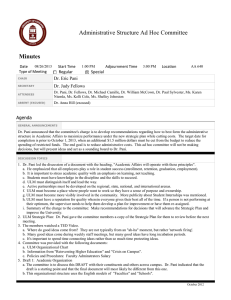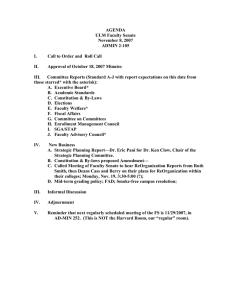Administrative Structure Ad Hoc Committee Minutes
advertisement

Administrative Structure Ad Hoc Committee Minutes SEPTEMBER 4, 2013 1:00-2:50 P.M. CHAIR Dr. Eric Pani SECRETARY Dr. Judy Fellows ATTENDEES Dr. Pani, Dr. Fellows, Dr. Michael Camille, Dr. William McCown, Dr. Paul Sylvester, Ms. Karen Niemla, Ms. Kelli Cole, Ms. Shelley Johnston ABSENT (EXCUSED) Dr. Anna Hill (excused) LIBRARY 640 Agenda topics GENERAL ANNOUNCEMENTS Dr. Pani requested that the committee share any comments received by commit tee members from the university community regarding the proposed "Academic Reorganization". Discussion Topic: Constituent Comments regarding the proposed academic reorganization 10 Major areas of concern were determined by the members of the committee based on comments from their constituents: DISCUSSION 1. What is the rationale for this sweeping re-organization (with nomenclature changes and reconfigurations)? Information has been unclear 2. “Principles” don’t recognize current behaviors a. Many/most programs already have a reputation for quality, etc., they don’t need to develop it b. Development of “intellectual property for commercialization” is unclear 3. Timeline untenable a. Although it has been expressed that this proposal needs to be ready for implementation on January 1, t he committee believes that in reality it will have to be ready before November 1 as students will begin registering for spring semester, and advising in October will occur under the current administrative structure. b. Concern was expressed about the logistics of implementation from a staff perspective: the time and expertise necessary to rewrite banner and payroll codes do not lend themselves to easy and fast implementation. c. The request was also made for staff to be provided more information about the proposed changes. d. Recruitment has already printed all of their documents for the year using the current administrative structure e. Re-assigning current administrators to the classroom requires course preparation time 4. Organization of programs not conducive to best practices a. Grouping Pharmacy and Health Sciences has not worked on at least two occasions in the past b. Placing the Graduate School in one of the “Faculties of” seems problematic c Concern was expressed that the thought seems to be “one size fits all”, which is not accurate for a university. Although one college at ULM has implemented the “school” concept, that college does not have accreditation requirements for its programs while the remainder of the colleges have to meet mandated accreditation requirements 5. Workload as related to “cut” positions a. More clarification is needed in regard to workload for cut positions (e.g, department heads and program directors) and workload/job duties for Assistant Vice Presidents and new positions b. Concern was expressed regarding how the proposed plan will accommodate the requirements of accredited programs, where standards require a discipline-specific program director. 6. Public perception a. The committee expressed the belief from their constituents that eliminating the term “colleges” will be used against ULM be its competitors who will make it appear that ULM is a weaker institution since it does not have colleges or Deans/Associate Deans. Examples given were four year colleges in the area and the Community College, all of which have colleges and deans. 7. Terminology a. “Faculties of” is an unclear term b. Accreditation agencies, the System office, and other offices ask for info rmation to be provided for/by “colleges”; not having “colleges” creates confusion for documentation 8. Graduate School placement a. The committee suggested that the Graduate School not be placed within one “Faculties”, but in stead report directly to the Vice President of Academic Affairs. 9. Accreditation issues a. Multiple issues related to accreditation were discussed b. The proposed structure seems to indicate that an Assistant Vice P resident, potentially not in the discipline, would have administrative control over accredited programs c. If Program Directors are maintained, how will their workload/compensation be configured and what accommodations will be made to continue to meet accreditation requirements when personnel are moved from 9 months to 12 months? 10. Cost/Benefit of the proposed reorganization on the suggested timeline a. What is the pay scale for the proposed new positions? b. It is doubtful that there will be an early retirement “buy -out” c. The question was asked whether there will be any administrative reorganization of the current Vice Presidents and Dr. Pani said that would be Dr. Bruno’s decision. d. Discussion was held regarding the impact of this propos al on Administrative Assistants e. Discussion was held regarding other ways to generate funds. Dr. Pani said that the University Conference Center (Library, 7 th floor) can now be rented by outside groups. Dr. Pani said that there are two major goals: Reduce administrative costs and provide more opportunities for collaboration. He said that he is not committed to “faculties” or “schools” he is only committed to reducing administrative costs and increasing collaboration. The committee expressed that collaboration cannot be legislated by grouping entities together. Dr. Pani remarked that if people are willing to collaborate, why is more not being done? In regard to collaboration, discussion was held about the collaboration that occurred when there was the old Faculty Club (before the SUB was renovated). Opportunities for collaboration occurred as faculty were served lunch as they met and mingled with faculty from other disciplines. The current room in the SUB does not provide the same type of environment. The article, “Crisis on Campus” that Dr. Pani assigned the committee to read, is the reason he wants collaboration. Dr. Pani expressed the desire for university unification once the decision is made. He said that it is his job to determine the best structure and once he does, he would expect every Dean, Department Head, and faculty member to adhere to the new structure. Dr. Pani provided the committee with fiscal information and explained why the only costs that can be reduced are staff and administration. CONCLUSIONS The next meeting is scheduled for Monday, September 9 at 1:00 ACTION ITEMS PERSON RESPONSIBLE Within the next week, Dr. Pani will send emails about the situation. He is planning to address what the problem is, what ULM’s options are, the rationale behind the proposal, and other information. Meetings with individual colleges may occur during the week of September 9. Dr. Pani DEADLINE

